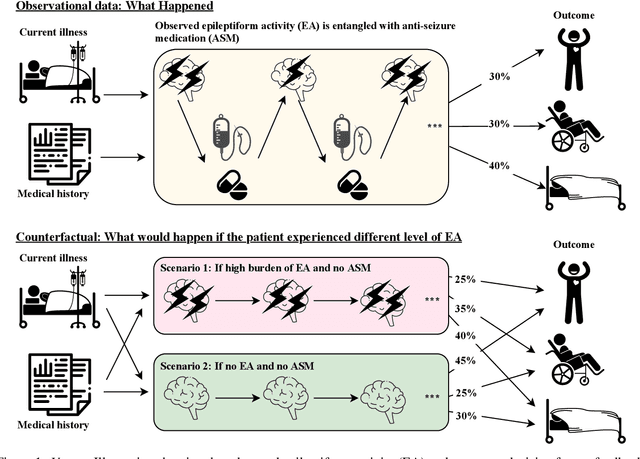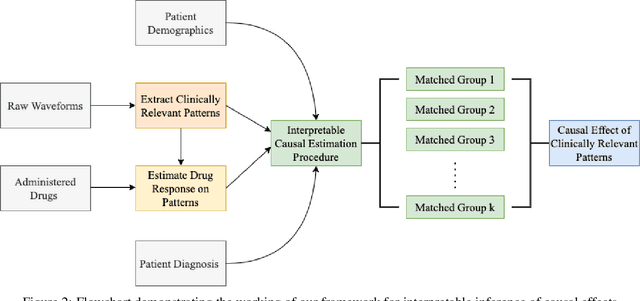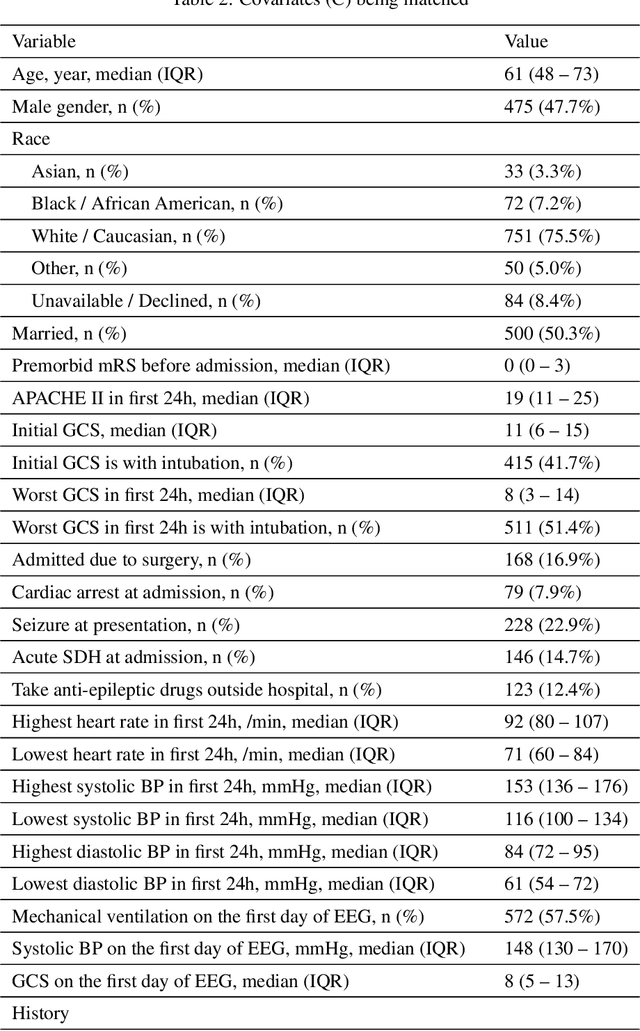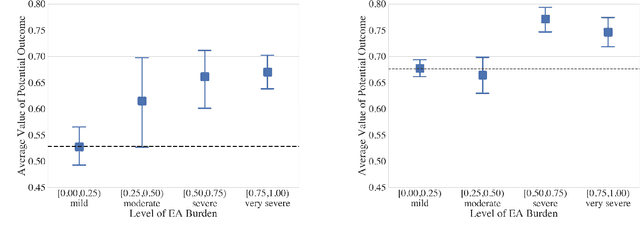Harsh Parikh
Graph Neural Network based Double Machine Learning Estimator of Network Causal Effects
Mar 17, 2024Abstract:Our paper addresses the challenge of inferring causal effects in social network data, characterized by complex interdependencies among individuals resulting in challenges such as non-independence of units, interference (where a unit's outcome is affected by neighbors' treatments), and introduction of additional confounding factors from neighboring units. We propose a novel methodology combining graph neural networks and double machine learning, enabling accurate and efficient estimation of direct and peer effects using a single observational social network. Our approach utilizes graph isomorphism networks in conjunction with double machine learning to effectively adjust for network confounders and consistently estimate the desired causal effects. We demonstrate that our estimator is both asymptotically normal and semiparametrically efficient. A comprehensive evaluation against four state-of-the-art baseline methods using three semi-synthetic social network datasets reveals our method's on-par or superior efficacy in precise causal effect estimation. Further, we illustrate the practical application of our method through a case study that investigates the impact of Self-Help Group participation on financial risk tolerance. The results indicate a significant positive direct effect, underscoring the potential of our approach in social network analysis. Additionally, we explore the effects of network sparsity on estimation performance.
Towards Generalizing Inferences from Trials to Target Populations
Feb 26, 2024Abstract:Randomized Controlled Trials (RCTs) are pivotal in generating internally valid estimates with minimal assumptions, serving as a cornerstone for researchers dedicated to advancing causal inference methods. However, extending these findings beyond the experimental cohort to achieve externally valid estimates is crucial for broader scientific inquiry. This paper delves into the forefront of addressing these external validity challenges, encapsulating the essence of a multidisciplinary workshop held at the Institute for Computational and Experimental Research in Mathematics (ICERM), Brown University, in Fall 2023. The workshop congregated experts from diverse fields including social science, medicine, public health, statistics, computer science, and education, to tackle the unique obstacles each discipline faces in extrapolating experimental findings. Our study presents three key contributions: we integrate ongoing efforts, highlighting methodological synergies across fields; provide an exhaustive review of generalizability and transportability based on the workshop's discourse; and identify persistent hurdles while suggesting avenues for future research. By doing so, this paper aims to enhance the collective understanding of the generalizability and transportability of causal effects, fostering cross-disciplinary collaboration and offering valuable insights for researchers working on refining and applying causal inference methods.
Who Are We Missing? A Principled Approach to Characterizing the Underrepresented Population
Jan 25, 2024Abstract:Randomized controlled trials (RCTs) serve as the cornerstone for understanding causal effects, yet extending inferences to target populations presents challenges due to effect heterogeneity and underrepresentation. Our paper addresses the critical issue of identifying and characterizing underrepresented subgroups in RCTs, proposing a novel framework for refining target populations to improve generalizability. We introduce an optimization-based approach, Rashomon Set of Optimal Trees (ROOT), to characterize underrepresented groups. ROOT optimizes the target subpopulation distribution by minimizing the variance of the target average treatment effect estimate, ensuring more precise treatment effect estimations. Notably, ROOT generates interpretable characteristics of the underrepresented population, aiding researchers in effective communication. Our approach demonstrates improved precision and interpretability compared to alternatives, as illustrated with synthetic data experiments. We apply our methodology to extend inferences from the Starting Treatment with Agonist Replacement Therapies (START) trial -- investigating the effectiveness of medication for opioid use disorder -- to the real-world population represented by the Treatment Episode Dataset: Admissions (TEDS-A). By refining target populations using ROOT, our framework offers a systematic approach to enhance decision-making accuracy and inform future trials in diverse populations.
Interpretable Causal Inference for Analyzing Wearable, Sensor, and Distributional Data
Dec 17, 2023Abstract:Many modern causal questions ask how treatments affect complex outcomes that are measured using wearable devices and sensors. Current analysis approaches require summarizing these data into scalar statistics (e.g., the mean), but these summaries can be misleading. For example, disparate distributions can have the same means, variances, and other statistics. Researchers can overcome the loss of information by instead representing the data as distributions. We develop an interpretable method for distributional data analysis that ensures trustworthy and robust decision-making: Analyzing Distributional Data via Matching After Learning to Stretch (ADD MALTS). We (i) provide analytical guarantees of the correctness of our estimation strategy, (ii) demonstrate via simulation that ADD MALTS outperforms other distributional data analysis methods at estimating treatment effects, and (iii) illustrate ADD MALTS' ability to verify whether there is enough cohesion between treatment and control units within subpopulations to trustworthily estimate treatment effects. We demonstrate ADD MALTS' utility by studying the effectiveness of continuous glucose monitors in mitigating diabetes risks.
Estimating Trustworthy and Safe Optimal Treatment Regimes
Oct 23, 2023Abstract:Recent statistical and reinforcement learning methods have significantly advanced patient care strategies. However, these approaches face substantial challenges in high-stakes contexts, including missing data, inherent stochasticity, and the critical requirements for interpretability and patient safety. Our work operationalizes a safe and interpretable framework to identify optimal treatment regimes. This approach involves matching patients with similar medical and pharmacological characteristics, allowing us to construct an optimal policy via interpolation. We perform a comprehensive simulation study to demonstrate the framework's ability to identify optimal policies even in complex settings. Ultimately, we operationalize our approach to study regimes for treating seizures in critically ill patients. Our findings strongly support personalized treatment strategies based on a patient's medical history and pharmacological features. Notably, we identify that reducing medication doses for patients with mild and brief seizure episodes while adopting aggressive treatment for patients in intensive care unit experiencing intense seizures leads to more favorable outcomes.
A Double Machine Learning Approach to Combining Experimental and Observational Data
Jul 04, 2023Abstract:Experimental and observational studies often lack validity due to untestable assumptions. We propose a double machine learning approach to combine experimental and observational studies, allowing practitioners to test for assumption violations and estimate treatment effects consistently. Our framework tests for violations of external validity and ignorability under milder assumptions. When only one assumption is violated, we provide semi-parametrically efficient treatment effect estimators. However, our no-free-lunch theorem highlights the necessity of accurately identifying the violated assumption for consistent treatment effect estimation. We demonstrate the applicability of our approach in three real-world case studies, highlighting its relevance for practical settings.
From Feature Importance to Distance Metric: An Almost Exact Matching Approach for Causal Inference
Feb 23, 2023Abstract:Our goal is to produce methods for observational causal inference that are auditable, easy to troubleshoot, yield accurate treatment effect estimates, and scalable to high-dimensional data. We describe an almost-exact matching approach that achieves these goals by (i) learning a distance metric via outcome modeling, (ii) creating matched groups using the distance metric, and (iii) using the matched groups to estimate treatment effects. Our proposed method uses variable importance measurements to construct a distance metric, making it a flexible method that can be adapted to various applications. Concentrating on the scalability of the problem in the number of potential confounders, we operationalize our approach with LASSO. We derive performance guarantees for settings where LASSO outcome modeling consistently identifies all confounders (importantly without requiring the linear model to be correctly specified). We also provide experimental results demonstrating the auditability of matches, as well as extensions to more general nonparametric outcome modeling.
Are Synthetic Control Weights Balancing Score?
Nov 03, 2022Abstract:In this short note, I outline conditions under which conditioning on Synthetic Control (SC) weights emulates a randomized control trial where the treatment status is independent of potential outcomes. Specifically, I demonstrate that if there exist SC weights such that (i) the treatment effects are exactly identified and (ii) these weights are uniformly and cumulatively bounded, then SC weights are balancing scores.
Why Interpretable Causal Inference is Important for High-Stakes Decision Making for Critically Ill Patients and How To Do It
Mar 09, 2022



Abstract:Many fundamental problems affecting the care of critically ill patients lead to similar analytical challenges: physicians cannot easily estimate the effects of at-risk medical conditions or treatments because the causal effects of medical conditions and drugs are entangled. They also cannot easily perform studies: there are not enough high-quality data for high-dimensional observational causal inference, and RCTs often cannot ethically be conducted. However, mechanistic knowledge is available, including how drugs are absorbed into the body, and the combination of this knowledge with the limited data could potentially suffice -- if we knew how to combine them. In this work, we present a framework for interpretable estimation of causal effects for critically ill patients under exactly these complex conditions: interactions between drugs and observations over time, patient data sets that are not large, and mechanistic knowledge that can substitute for lack of data. We apply this framework to an extremely important problem affecting critically ill patients, namely the effect of seizures and other potentially harmful electrical events in the brain (called epileptiform activity -- EA) on outcomes. Given the high stakes involved and the high noise in the data, interpretability is critical for troubleshooting such complex problems. Interpretability of our matched groups allowed neurologists to perform chart reviews to verify the quality of our causal analysis. For instance, our work indicates that a patient who experiences a high level of seizure-like activity (75% high EA burden) and is untreated for a six-hour window, has, on average, a 16.7% increased chance of adverse outcomes such as severe brain damage, lifetime disability, or death. We find that patients with mild but long-lasting EA (average EA burden >= 50%) have their risk of an adverse outcome increased by 11.2%.
Evaluating Causal Inference Methods
Feb 10, 2022



Abstract:The fundamental challenge of drawing causal inference is that counterfactual outcomes are not fully observed for any unit. Furthermore, in observational studies, treatment assignment is likely to be confounded. Many statistical methods have emerged for causal inference under unconfoundedness conditions given pre-treatment covariates, including propensity score-based methods, prognostic score-based methods, and doubly robust methods. Unfortunately for applied researchers, there is no `one-size-fits-all' causal method that can perform optimally universally. In practice, causal methods are primarily evaluated quantitatively on handcrafted simulated data. Such data-generative procedures can be of limited value because they are typically stylized models of reality. They are simplified for tractability and lack the complexities of real-world data. For applied researchers, it is critical to understand how well a method performs for the data at hand. Our work introduces a deep generative model-based framework, Credence, to validate causal inference methods. The framework's novelty stems from its ability to generate synthetic data anchored at the empirical distribution for the observed sample, and therefore virtually indistinguishable from the latter. The approach allows the user to specify ground truth for the form and magnitude of causal effects and confounding bias as functions of covariates. Thus simulated data sets are used to evaluate the potential performance of various causal estimation methods when applied to data similar to the observed sample. We demonstrate Credence's ability to accurately assess the relative performance of causal estimation techniques in an extensive simulation study and two real-world data applications from Lalonde and Project STAR studies.
 Add to Chrome
Add to Chrome Add to Firefox
Add to Firefox Add to Edge
Add to Edge